Organizational Behavior Report
VerifiedAdded on 2020/01/07
|11
|3260
|164
Report
AI Summary
This report explores organizational behavior, focusing on the Chartered Management Institute and Chartered Institute of Personal and Development. It compares their organizational structures (line vs. divisional) and cultures (role vs. task), analyzing the effects on organizational performance. Different leadership styles (autocratic and democratic) are compared, and the influence of leadership style, work environment, and empowerment on individual behavior is examined. The report also discusses factors influencing workplace practices, referencing Henry Fayol's theory of management. Finally, it evaluates the importance of teamwork and suggests ways to improve it using modern technology (video conferencing, mobile technology, email, and database management systems).
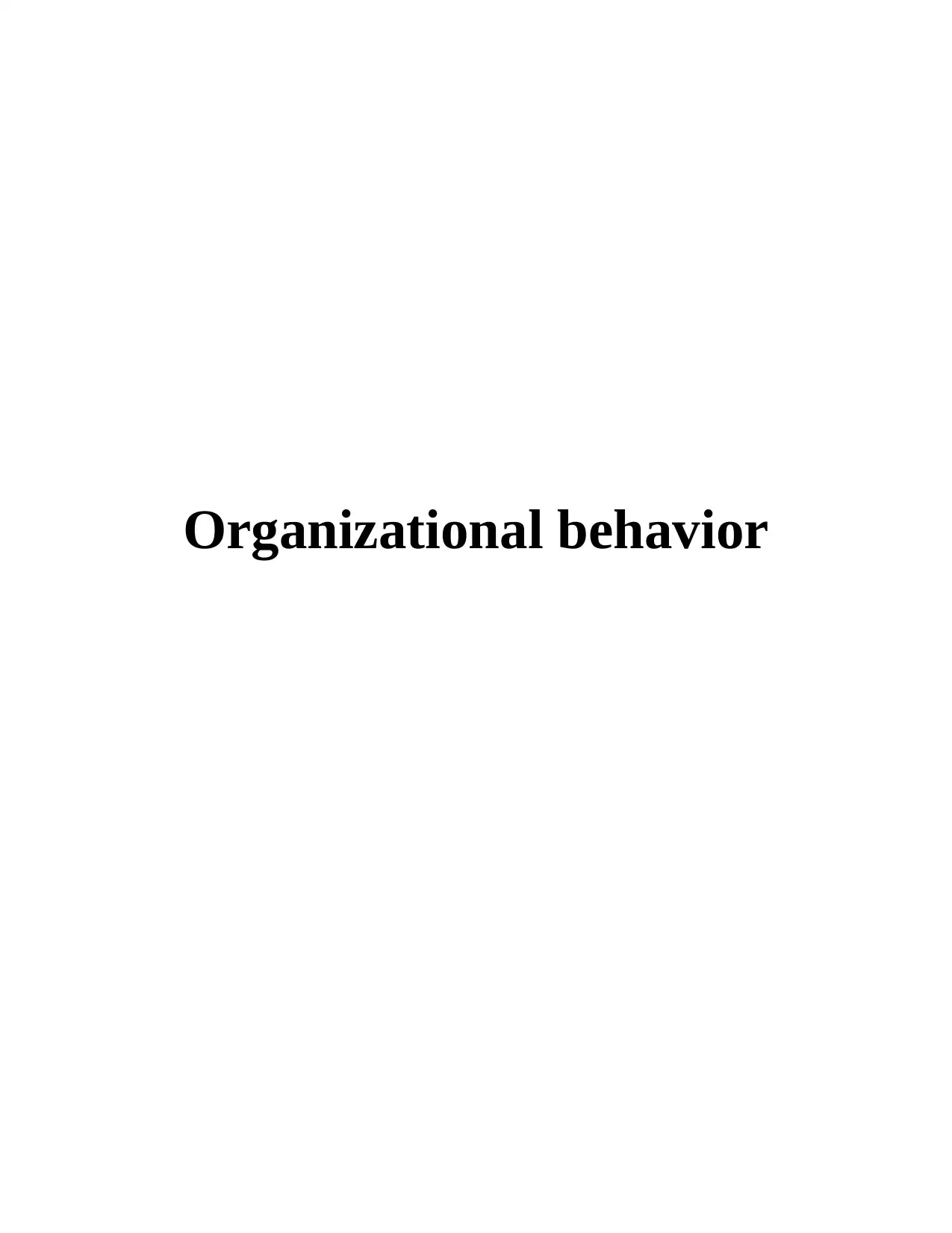
Organizational behavior
Paraphrase This Document
Need a fresh take? Get an instant paraphrase of this document with our AI Paraphraser
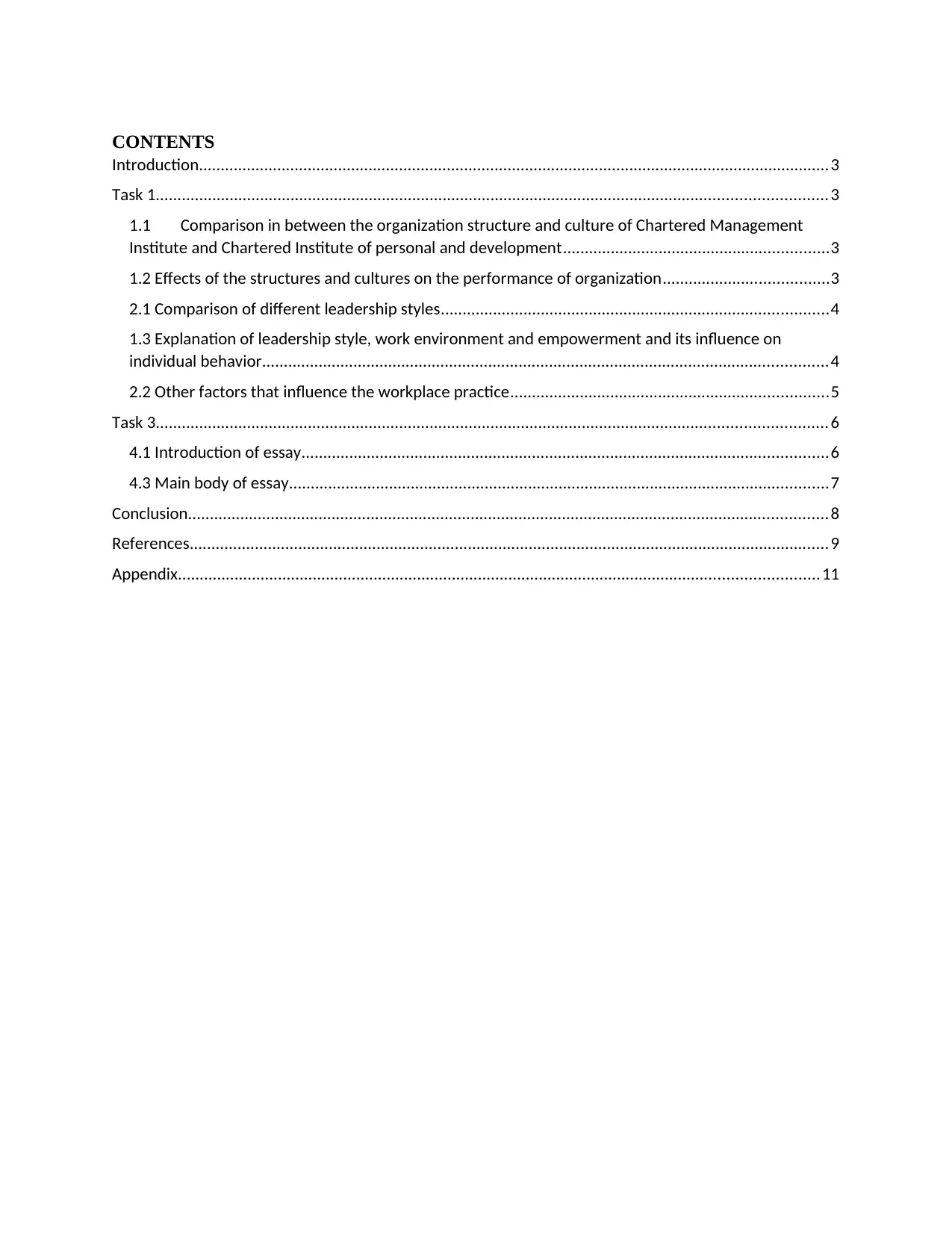
CONTENTS
Introduction.................................................................................................................................................3
Task 1..........................................................................................................................................................3
1.1 Comparison in between the organization structure and culture of Chartered Management
Institute and Chartered Institute of personal and development.............................................................3
1.2 Effects of the structures and cultures on the performance of organization......................................3
2.1 Comparison of different leadership styles.........................................................................................4
1.3 Explanation of leadership style, work environment and empowerment and its influence on
individual behavior..................................................................................................................................4
2.2 Other factors that influence the workplace practice.........................................................................5
Task 3..........................................................................................................................................................6
4.1 Introduction of essay.........................................................................................................................6
4.3 Main body of essay............................................................................................................................7
Conclusion...................................................................................................................................................8
References...................................................................................................................................................9
Appendix...................................................................................................................................................11
Introduction.................................................................................................................................................3
Task 1..........................................................................................................................................................3
1.1 Comparison in between the organization structure and culture of Chartered Management
Institute and Chartered Institute of personal and development.............................................................3
1.2 Effects of the structures and cultures on the performance of organization......................................3
2.1 Comparison of different leadership styles.........................................................................................4
1.3 Explanation of leadership style, work environment and empowerment and its influence on
individual behavior..................................................................................................................................4
2.2 Other factors that influence the workplace practice.........................................................................5
Task 3..........................................................................................................................................................6
4.1 Introduction of essay.........................................................................................................................6
4.3 Main body of essay............................................................................................................................7
Conclusion...................................................................................................................................................8
References...................................................................................................................................................9
Appendix...................................................................................................................................................11
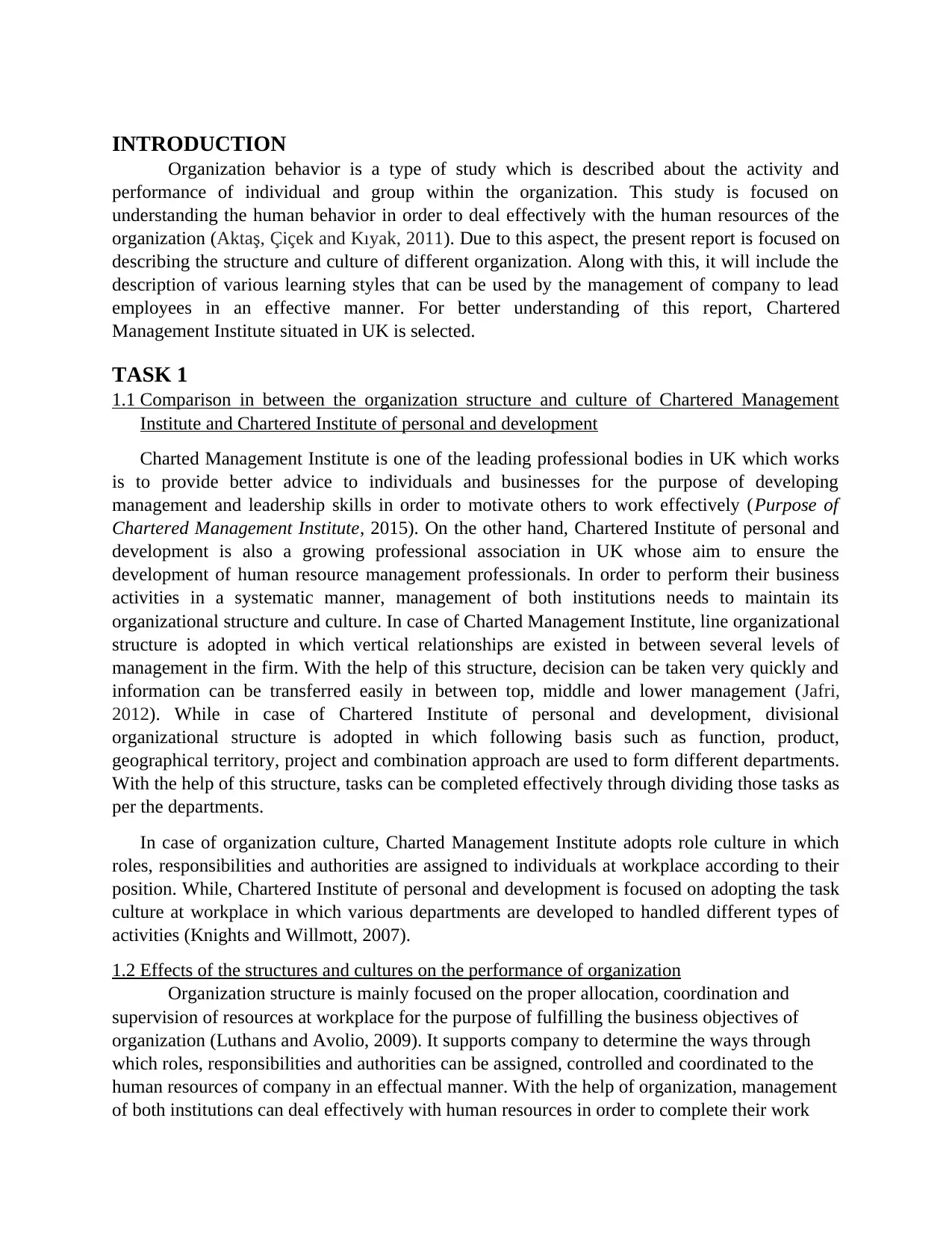
INTRODUCTION
Organization behavior is a type of study which is described about the activity and
performance of individual and group within the organization. This study is focused on
understanding the human behavior in order to deal effectively with the human resources of the
organization (Aktaş, Çiçek and Kıyak, 2011). Due to this aspect, the present report is focused on
describing the structure and culture of different organization. Along with this, it will include the
description of various learning styles that can be used by the management of company to lead
employees in an effective manner. For better understanding of this report, Chartered
Management Institute situated in UK is selected.
TASK 1
1.1 Comparison in between the organization structure and culture of Chartered Management
Institute and Chartered Institute of personal and development
Charted Management Institute is one of the leading professional bodies in UK which works
is to provide better advice to individuals and businesses for the purpose of developing
management and leadership skills in order to motivate others to work effectively (Purpose of
Chartered Management Institute, 2015). On the other hand, Chartered Institute of personal and
development is also a growing professional association in UK whose aim to ensure the
development of human resource management professionals. In order to perform their business
activities in a systematic manner, management of both institutions needs to maintain its
organizational structure and culture. In case of Charted Management Institute, line organizational
structure is adopted in which vertical relationships are existed in between several levels of
management in the firm. With the help of this structure, decision can be taken very quickly and
information can be transferred easily in between top, middle and lower management (Jafri,
2012). While in case of Chartered Institute of personal and development, divisional
organizational structure is adopted in which following basis such as function, product,
geographical territory, project and combination approach are used to form different departments.
With the help of this structure, tasks can be completed effectively through dividing those tasks as
per the departments.
In case of organization culture, Charted Management Institute adopts role culture in which
roles, responsibilities and authorities are assigned to individuals at workplace according to their
position. While, Chartered Institute of personal and development is focused on adopting the task
culture at workplace in which various departments are developed to handled different types of
activities (Knights and Willmott, 2007).
1.2 Effects of the structures and cultures on the performance of organization
Organization structure is mainly focused on the proper allocation, coordination and
supervision of resources at workplace for the purpose of fulfilling the business objectives of
organization (Luthans and Avolio, 2009). It supports company to determine the ways through
which roles, responsibilities and authorities can be assigned, controlled and coordinated to the
human resources of company in an effectual manner. With the help of organization, management
of both institutions can deal effectively with human resources in order to complete their work
Organization behavior is a type of study which is described about the activity and
performance of individual and group within the organization. This study is focused on
understanding the human behavior in order to deal effectively with the human resources of the
organization (Aktaş, Çiçek and Kıyak, 2011). Due to this aspect, the present report is focused on
describing the structure and culture of different organization. Along with this, it will include the
description of various learning styles that can be used by the management of company to lead
employees in an effective manner. For better understanding of this report, Chartered
Management Institute situated in UK is selected.
TASK 1
1.1 Comparison in between the organization structure and culture of Chartered Management
Institute and Chartered Institute of personal and development
Charted Management Institute is one of the leading professional bodies in UK which works
is to provide better advice to individuals and businesses for the purpose of developing
management and leadership skills in order to motivate others to work effectively (Purpose of
Chartered Management Institute, 2015). On the other hand, Chartered Institute of personal and
development is also a growing professional association in UK whose aim to ensure the
development of human resource management professionals. In order to perform their business
activities in a systematic manner, management of both institutions needs to maintain its
organizational structure and culture. In case of Charted Management Institute, line organizational
structure is adopted in which vertical relationships are existed in between several levels of
management in the firm. With the help of this structure, decision can be taken very quickly and
information can be transferred easily in between top, middle and lower management (Jafri,
2012). While in case of Chartered Institute of personal and development, divisional
organizational structure is adopted in which following basis such as function, product,
geographical territory, project and combination approach are used to form different departments.
With the help of this structure, tasks can be completed effectively through dividing those tasks as
per the departments.
In case of organization culture, Charted Management Institute adopts role culture in which
roles, responsibilities and authorities are assigned to individuals at workplace according to their
position. While, Chartered Institute of personal and development is focused on adopting the task
culture at workplace in which various departments are developed to handled different types of
activities (Knights and Willmott, 2007).
1.2 Effects of the structures and cultures on the performance of organization
Organization structure is mainly focused on the proper allocation, coordination and
supervision of resources at workplace for the purpose of fulfilling the business objectives of
organization (Luthans and Avolio, 2009). It supports company to determine the ways through
which roles, responsibilities and authorities can be assigned, controlled and coordinated to the
human resources of company in an effectual manner. With the help of organization, management
of both institutions can deal effectively with human resources in order to complete their work
⊘ This is a preview!⊘
Do you want full access?
Subscribe today to unlock all pages.

Trusted by 1+ million students worldwide
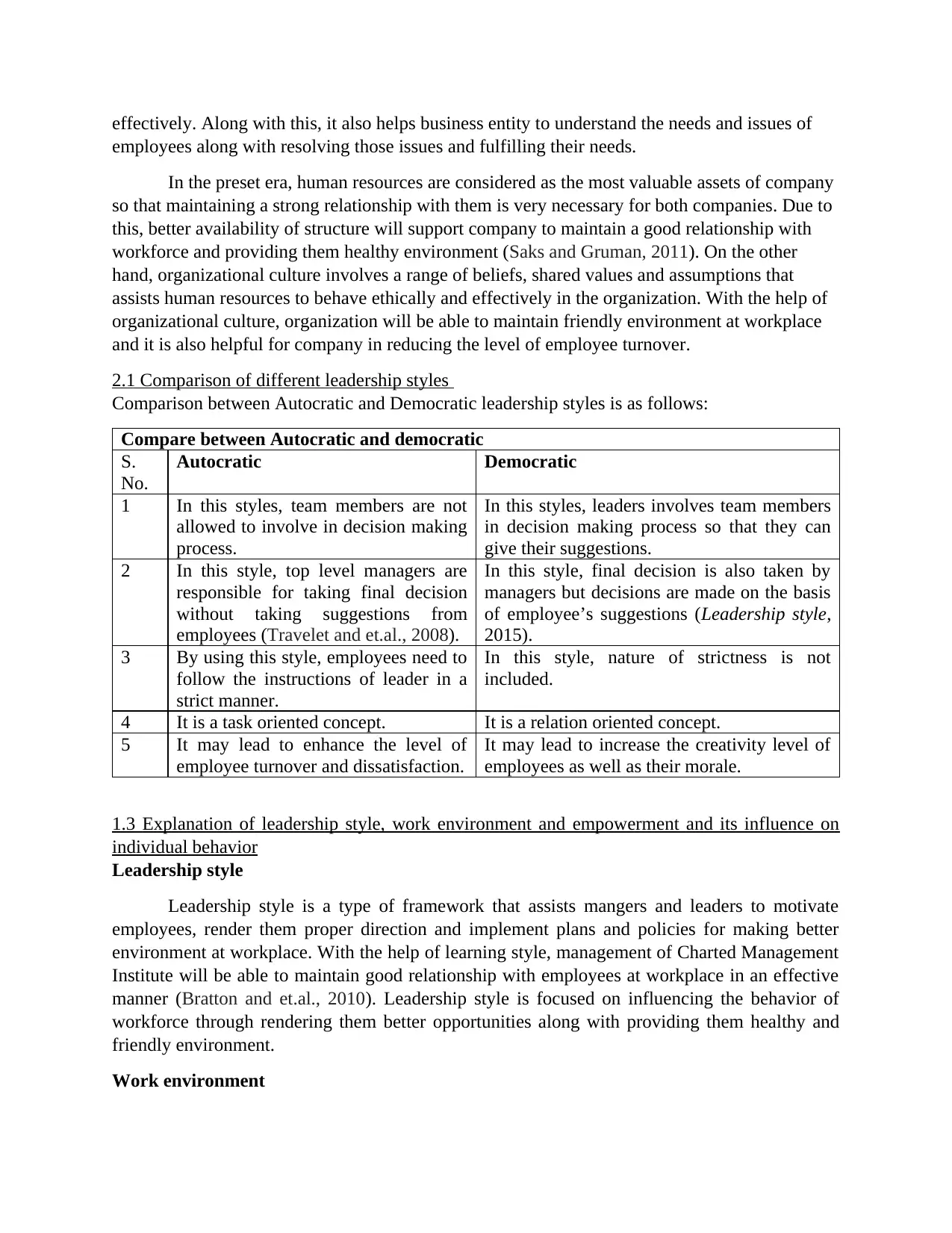
effectively. Along with this, it also helps business entity to understand the needs and issues of
employees along with resolving those issues and fulfilling their needs.
In the preset era, human resources are considered as the most valuable assets of company
so that maintaining a strong relationship with them is very necessary for both companies. Due to
this, better availability of structure will support company to maintain a good relationship with
workforce and providing them healthy environment (Saks and Gruman, 2011). On the other
hand, organizational culture involves a range of beliefs, shared values and assumptions that
assists human resources to behave ethically and effectively in the organization. With the help of
organizational culture, organization will be able to maintain friendly environment at workplace
and it is also helpful for company in reducing the level of employee turnover.
2.1 Comparison of different leadership styles
Comparison between Autocratic and Democratic leadership styles is as follows:
Compare between Autocratic and democratic
S.
No.
Autocratic Democratic
1 In this styles, team members are not
allowed to involve in decision making
process.
In this styles, leaders involves team members
in decision making process so that they can
give their suggestions.
2 In this style, top level managers are
responsible for taking final decision
without taking suggestions from
employees (Travelet and et.al., 2008).
In this style, final decision is also taken by
managers but decisions are made on the basis
of employee’s suggestions (Leadership style,
2015).
3 By using this style, employees need to
follow the instructions of leader in a
strict manner.
In this style, nature of strictness is not
included.
4 It is a task oriented concept. It is a relation oriented concept.
5 It may lead to enhance the level of
employee turnover and dissatisfaction.
It may lead to increase the creativity level of
employees as well as their morale.
1.3 Explanation of leadership style, work environment and empowerment and its influence on
individual behavior
Leadership style
Leadership style is a type of framework that assists mangers and leaders to motivate
employees, render them proper direction and implement plans and policies for making better
environment at workplace. With the help of learning style, management of Charted Management
Institute will be able to maintain good relationship with employees at workplace in an effective
manner (Bratton and et.al., 2010). Leadership style is focused on influencing the behavior of
workforce through rendering them better opportunities along with providing them healthy and
friendly environment.
Work environment
employees along with resolving those issues and fulfilling their needs.
In the preset era, human resources are considered as the most valuable assets of company
so that maintaining a strong relationship with them is very necessary for both companies. Due to
this, better availability of structure will support company to maintain a good relationship with
workforce and providing them healthy environment (Saks and Gruman, 2011). On the other
hand, organizational culture involves a range of beliefs, shared values and assumptions that
assists human resources to behave ethically and effectively in the organization. With the help of
organizational culture, organization will be able to maintain friendly environment at workplace
and it is also helpful for company in reducing the level of employee turnover.
2.1 Comparison of different leadership styles
Comparison between Autocratic and Democratic leadership styles is as follows:
Compare between Autocratic and democratic
S.
No.
Autocratic Democratic
1 In this styles, team members are not
allowed to involve in decision making
process.
In this styles, leaders involves team members
in decision making process so that they can
give their suggestions.
2 In this style, top level managers are
responsible for taking final decision
without taking suggestions from
employees (Travelet and et.al., 2008).
In this style, final decision is also taken by
managers but decisions are made on the basis
of employee’s suggestions (Leadership style,
2015).
3 By using this style, employees need to
follow the instructions of leader in a
strict manner.
In this style, nature of strictness is not
included.
4 It is a task oriented concept. It is a relation oriented concept.
5 It may lead to enhance the level of
employee turnover and dissatisfaction.
It may lead to increase the creativity level of
employees as well as their morale.
1.3 Explanation of leadership style, work environment and empowerment and its influence on
individual behavior
Leadership style
Leadership style is a type of framework that assists mangers and leaders to motivate
employees, render them proper direction and implement plans and policies for making better
environment at workplace. With the help of learning style, management of Charted Management
Institute will be able to maintain good relationship with employees at workplace in an effective
manner (Bratton and et.al., 2010). Leadership style is focused on influencing the behavior of
workforce through rendering them better opportunities along with providing them healthy and
friendly environment.
Work environment
Paraphrase This Document
Need a fresh take? Get an instant paraphrase of this document with our AI Paraphraser
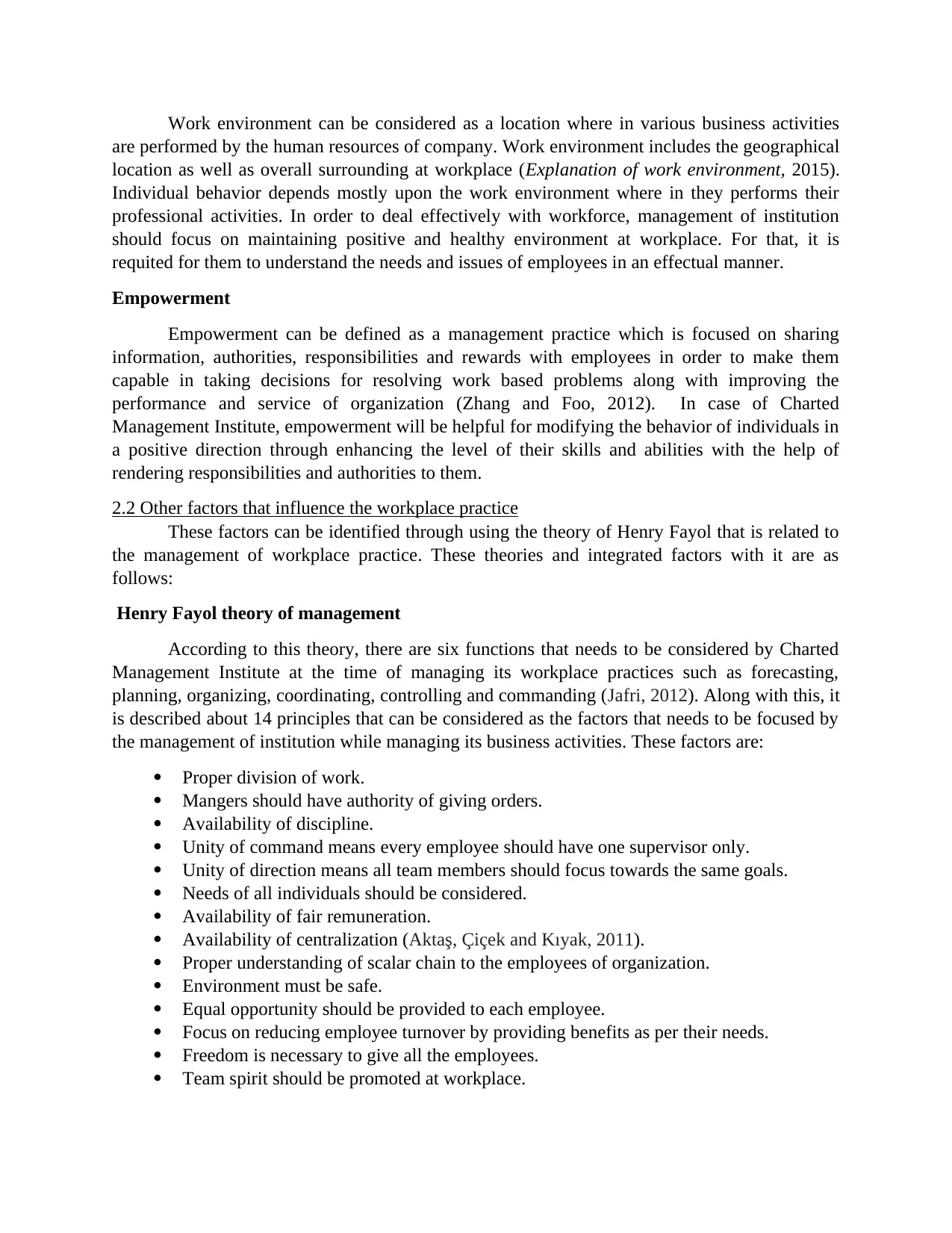
Work environment can be considered as a location where in various business activities
are performed by the human resources of company. Work environment includes the geographical
location as well as overall surrounding at workplace (Explanation of work environment, 2015).
Individual behavior depends mostly upon the work environment where in they performs their
professional activities. In order to deal effectively with workforce, management of institution
should focus on maintaining positive and healthy environment at workplace. For that, it is
requited for them to understand the needs and issues of employees in an effectual manner.
Empowerment
Empowerment can be defined as a management practice which is focused on sharing
information, authorities, responsibilities and rewards with employees in order to make them
capable in taking decisions for resolving work based problems along with improving the
performance and service of organization (Zhang and Foo, 2012). In case of Charted
Management Institute, empowerment will be helpful for modifying the behavior of individuals in
a positive direction through enhancing the level of their skills and abilities with the help of
rendering responsibilities and authorities to them.
2.2 Other factors that influence the workplace practice
These factors can be identified through using the theory of Henry Fayol that is related to
the management of workplace practice. These theories and integrated factors with it are as
follows:
Henry Fayol theory of management
According to this theory, there are six functions that needs to be considered by Charted
Management Institute at the time of managing its workplace practices such as forecasting,
planning, organizing, coordinating, controlling and commanding (Jafri, 2012). Along with this, it
is described about 14 principles that can be considered as the factors that needs to be focused by
the management of institution while managing its business activities. These factors are:
Proper division of work.
Mangers should have authority of giving orders.
Availability of discipline.
Unity of command means every employee should have one supervisor only.
Unity of direction means all team members should focus towards the same goals.
Needs of all individuals should be considered.
Availability of fair remuneration.
Availability of centralization (Aktaş, Çiçek and Kıyak, 2011).
Proper understanding of scalar chain to the employees of organization.
Environment must be safe.
Equal opportunity should be provided to each employee.
Focus on reducing employee turnover by providing benefits as per their needs.
Freedom is necessary to give all the employees.
Team spirit should be promoted at workplace.
are performed by the human resources of company. Work environment includes the geographical
location as well as overall surrounding at workplace (Explanation of work environment, 2015).
Individual behavior depends mostly upon the work environment where in they performs their
professional activities. In order to deal effectively with workforce, management of institution
should focus on maintaining positive and healthy environment at workplace. For that, it is
requited for them to understand the needs and issues of employees in an effectual manner.
Empowerment
Empowerment can be defined as a management practice which is focused on sharing
information, authorities, responsibilities and rewards with employees in order to make them
capable in taking decisions for resolving work based problems along with improving the
performance and service of organization (Zhang and Foo, 2012). In case of Charted
Management Institute, empowerment will be helpful for modifying the behavior of individuals in
a positive direction through enhancing the level of their skills and abilities with the help of
rendering responsibilities and authorities to them.
2.2 Other factors that influence the workplace practice
These factors can be identified through using the theory of Henry Fayol that is related to
the management of workplace practice. These theories and integrated factors with it are as
follows:
Henry Fayol theory of management
According to this theory, there are six functions that needs to be considered by Charted
Management Institute at the time of managing its workplace practices such as forecasting,
planning, organizing, coordinating, controlling and commanding (Jafri, 2012). Along with this, it
is described about 14 principles that can be considered as the factors that needs to be focused by
the management of institution while managing its business activities. These factors are:
Proper division of work.
Mangers should have authority of giving orders.
Availability of discipline.
Unity of command means every employee should have one supervisor only.
Unity of direction means all team members should focus towards the same goals.
Needs of all individuals should be considered.
Availability of fair remuneration.
Availability of centralization (Aktaş, Çiçek and Kıyak, 2011).
Proper understanding of scalar chain to the employees of organization.
Environment must be safe.
Equal opportunity should be provided to each employee.
Focus on reducing employee turnover by providing benefits as per their needs.
Freedom is necessary to give all the employees.
Team spirit should be promoted at workplace.
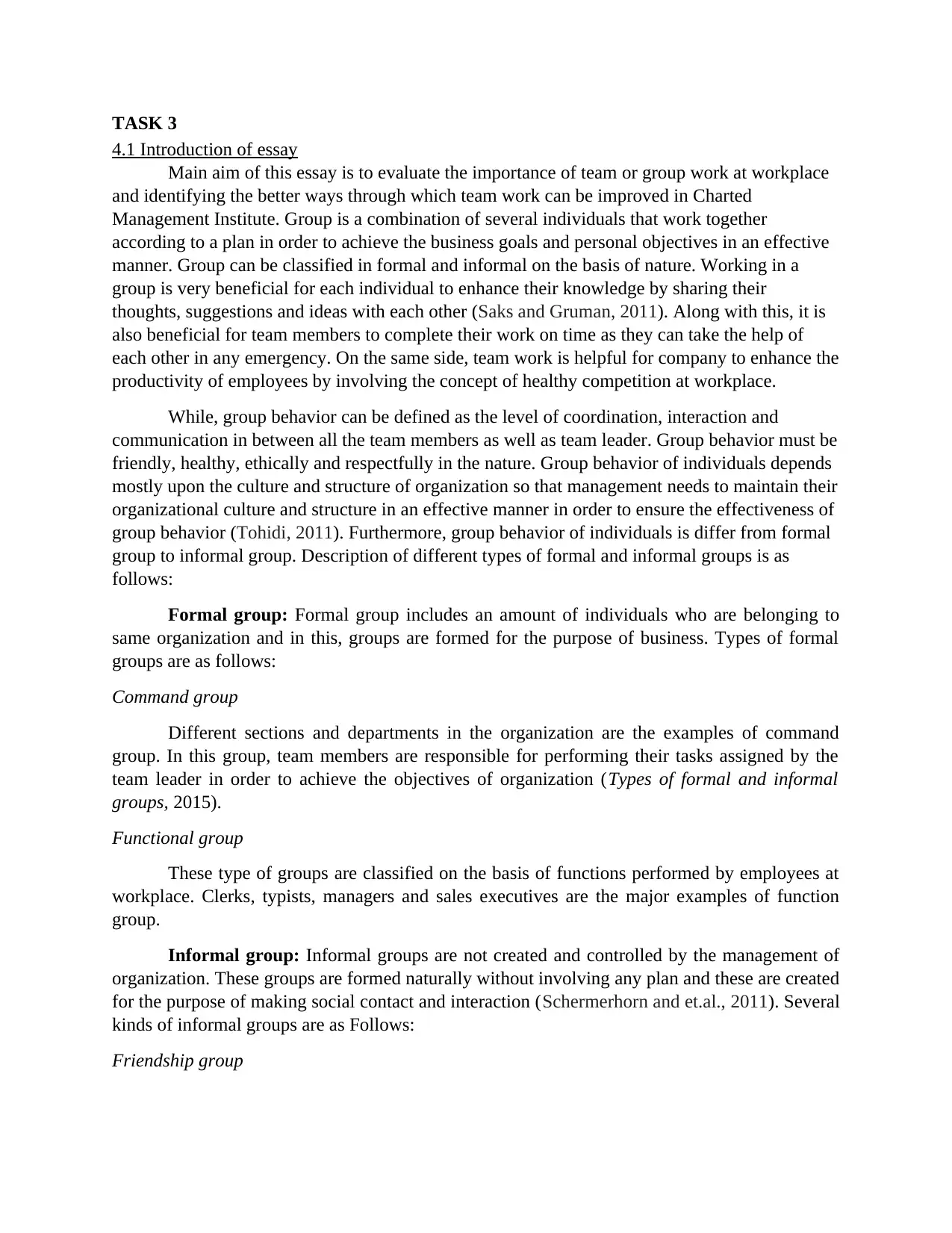
TASK 3
4.1 Introduction of essay
Main aim of this essay is to evaluate the importance of team or group work at workplace
and identifying the better ways through which team work can be improved in Charted
Management Institute. Group is a combination of several individuals that work together
according to a plan in order to achieve the business goals and personal objectives in an effective
manner. Group can be classified in formal and informal on the basis of nature. Working in a
group is very beneficial for each individual to enhance their knowledge by sharing their
thoughts, suggestions and ideas with each other (Saks and Gruman, 2011). Along with this, it is
also beneficial for team members to complete their work on time as they can take the help of
each other in any emergency. On the same side, team work is helpful for company to enhance the
productivity of employees by involving the concept of healthy competition at workplace.
While, group behavior can be defined as the level of coordination, interaction and
communication in between all the team members as well as team leader. Group behavior must be
friendly, healthy, ethically and respectfully in the nature. Group behavior of individuals depends
mostly upon the culture and structure of organization so that management needs to maintain their
organizational culture and structure in an effective manner in order to ensure the effectiveness of
group behavior (Tohidi, 2011). Furthermore, group behavior of individuals is differ from formal
group to informal group. Description of different types of formal and informal groups is as
follows:
Formal group: Formal group includes an amount of individuals who are belonging to
same organization and in this, groups are formed for the purpose of business. Types of formal
groups are as follows:
Command group
Different sections and departments in the organization are the examples of command
group. In this group, team members are responsible for performing their tasks assigned by the
team leader in order to achieve the objectives of organization (Types of formal and informal
groups, 2015).
Functional group
These type of groups are classified on the basis of functions performed by employees at
workplace. Clerks, typists, managers and sales executives are the major examples of function
group.
Informal group: Informal groups are not created and controlled by the management of
organization. These groups are formed naturally without involving any plan and these are created
for the purpose of making social contact and interaction (Schermerhorn and et.al., 2011). Several
kinds of informal groups are as Follows:
Friendship group
4.1 Introduction of essay
Main aim of this essay is to evaluate the importance of team or group work at workplace
and identifying the better ways through which team work can be improved in Charted
Management Institute. Group is a combination of several individuals that work together
according to a plan in order to achieve the business goals and personal objectives in an effective
manner. Group can be classified in formal and informal on the basis of nature. Working in a
group is very beneficial for each individual to enhance their knowledge by sharing their
thoughts, suggestions and ideas with each other (Saks and Gruman, 2011). Along with this, it is
also beneficial for team members to complete their work on time as they can take the help of
each other in any emergency. On the same side, team work is helpful for company to enhance the
productivity of employees by involving the concept of healthy competition at workplace.
While, group behavior can be defined as the level of coordination, interaction and
communication in between all the team members as well as team leader. Group behavior must be
friendly, healthy, ethically and respectfully in the nature. Group behavior of individuals depends
mostly upon the culture and structure of organization so that management needs to maintain their
organizational culture and structure in an effective manner in order to ensure the effectiveness of
group behavior (Tohidi, 2011). Furthermore, group behavior of individuals is differ from formal
group to informal group. Description of different types of formal and informal groups is as
follows:
Formal group: Formal group includes an amount of individuals who are belonging to
same organization and in this, groups are formed for the purpose of business. Types of formal
groups are as follows:
Command group
Different sections and departments in the organization are the examples of command
group. In this group, team members are responsible for performing their tasks assigned by the
team leader in order to achieve the objectives of organization (Types of formal and informal
groups, 2015).
Functional group
These type of groups are classified on the basis of functions performed by employees at
workplace. Clerks, typists, managers and sales executives are the major examples of function
group.
Informal group: Informal groups are not created and controlled by the management of
organization. These groups are formed naturally without involving any plan and these are created
for the purpose of making social contact and interaction (Schermerhorn and et.al., 2011). Several
kinds of informal groups are as Follows:
Friendship group
⊘ This is a preview!⊘
Do you want full access?
Subscribe today to unlock all pages.

Trusted by 1+ million students worldwide
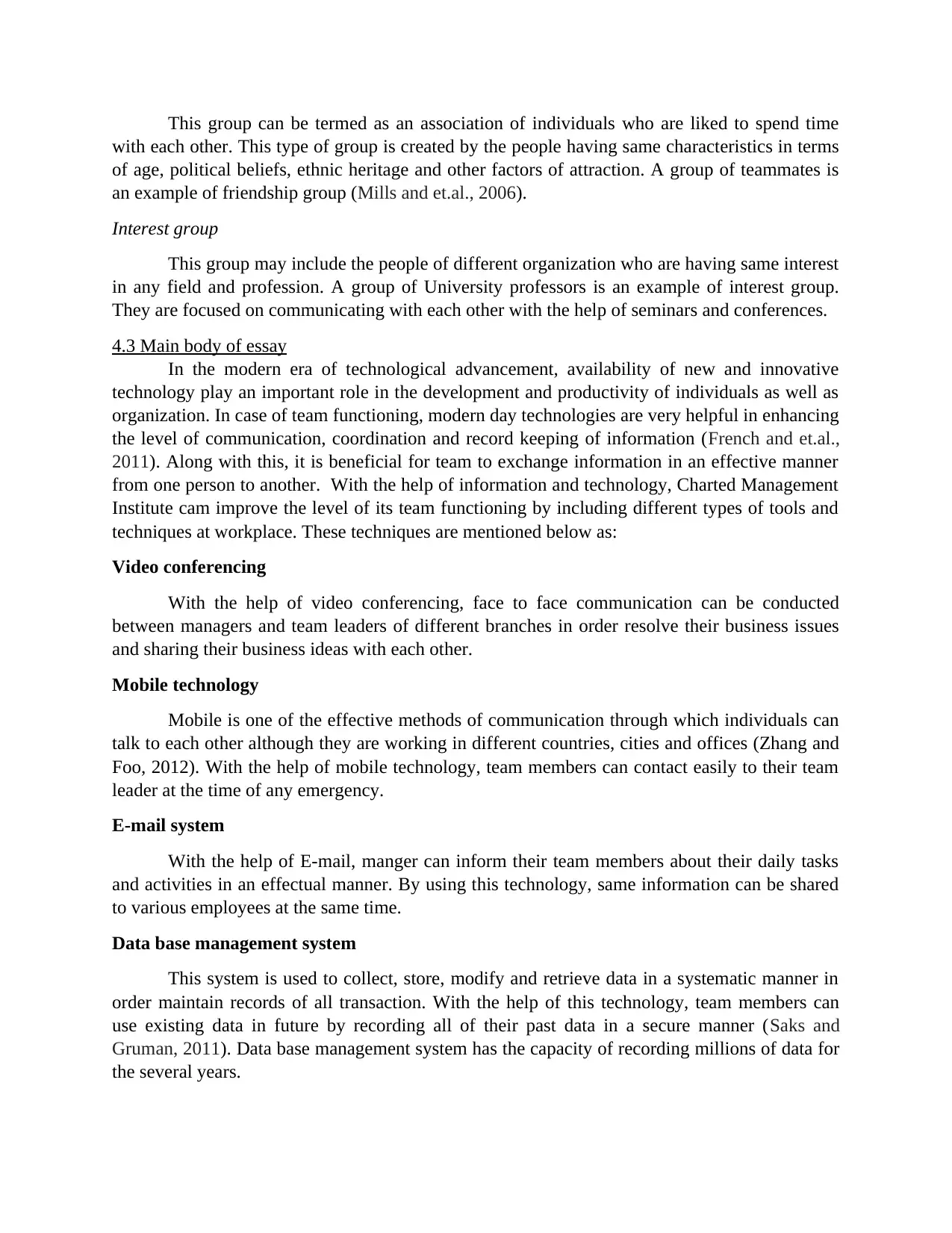
This group can be termed as an association of individuals who are liked to spend time
with each other. This type of group is created by the people having same characteristics in terms
of age, political beliefs, ethnic heritage and other factors of attraction. A group of teammates is
an example of friendship group (Mills and et.al., 2006).
Interest group
This group may include the people of different organization who are having same interest
in any field and profession. A group of University professors is an example of interest group.
They are focused on communicating with each other with the help of seminars and conferences.
4.3 Main body of essay
In the modern era of technological advancement, availability of new and innovative
technology play an important role in the development and productivity of individuals as well as
organization. In case of team functioning, modern day technologies are very helpful in enhancing
the level of communication, coordination and record keeping of information (French and et.al.,
2011). Along with this, it is beneficial for team to exchange information in an effective manner
from one person to another. With the help of information and technology, Charted Management
Institute cam improve the level of its team functioning by including different types of tools and
techniques at workplace. These techniques are mentioned below as:
Video conferencing
With the help of video conferencing, face to face communication can be conducted
between managers and team leaders of different branches in order resolve their business issues
and sharing their business ideas with each other.
Mobile technology
Mobile is one of the effective methods of communication through which individuals can
talk to each other although they are working in different countries, cities and offices (Zhang and
Foo, 2012). With the help of mobile technology, team members can contact easily to their team
leader at the time of any emergency.
E-mail system
With the help of E-mail, manger can inform their team members about their daily tasks
and activities in an effectual manner. By using this technology, same information can be shared
to various employees at the same time.
Data base management system
This system is used to collect, store, modify and retrieve data in a systematic manner in
order maintain records of all transaction. With the help of this technology, team members can
use existing data in future by recording all of their past data in a secure manner (Saks and
Gruman, 2011). Data base management system has the capacity of recording millions of data for
the several years.
with each other. This type of group is created by the people having same characteristics in terms
of age, political beliefs, ethnic heritage and other factors of attraction. A group of teammates is
an example of friendship group (Mills and et.al., 2006).
Interest group
This group may include the people of different organization who are having same interest
in any field and profession. A group of University professors is an example of interest group.
They are focused on communicating with each other with the help of seminars and conferences.
4.3 Main body of essay
In the modern era of technological advancement, availability of new and innovative
technology play an important role in the development and productivity of individuals as well as
organization. In case of team functioning, modern day technologies are very helpful in enhancing
the level of communication, coordination and record keeping of information (French and et.al.,
2011). Along with this, it is beneficial for team to exchange information in an effective manner
from one person to another. With the help of information and technology, Charted Management
Institute cam improve the level of its team functioning by including different types of tools and
techniques at workplace. These techniques are mentioned below as:
Video conferencing
With the help of video conferencing, face to face communication can be conducted
between managers and team leaders of different branches in order resolve their business issues
and sharing their business ideas with each other.
Mobile technology
Mobile is one of the effective methods of communication through which individuals can
talk to each other although they are working in different countries, cities and offices (Zhang and
Foo, 2012). With the help of mobile technology, team members can contact easily to their team
leader at the time of any emergency.
E-mail system
With the help of E-mail, manger can inform their team members about their daily tasks
and activities in an effectual manner. By using this technology, same information can be shared
to various employees at the same time.
Data base management system
This system is used to collect, store, modify and retrieve data in a systematic manner in
order maintain records of all transaction. With the help of this technology, team members can
use existing data in future by recording all of their past data in a secure manner (Saks and
Gruman, 2011). Data base management system has the capacity of recording millions of data for
the several years.
Paraphrase This Document
Need a fresh take? Get an instant paraphrase of this document with our AI Paraphraser
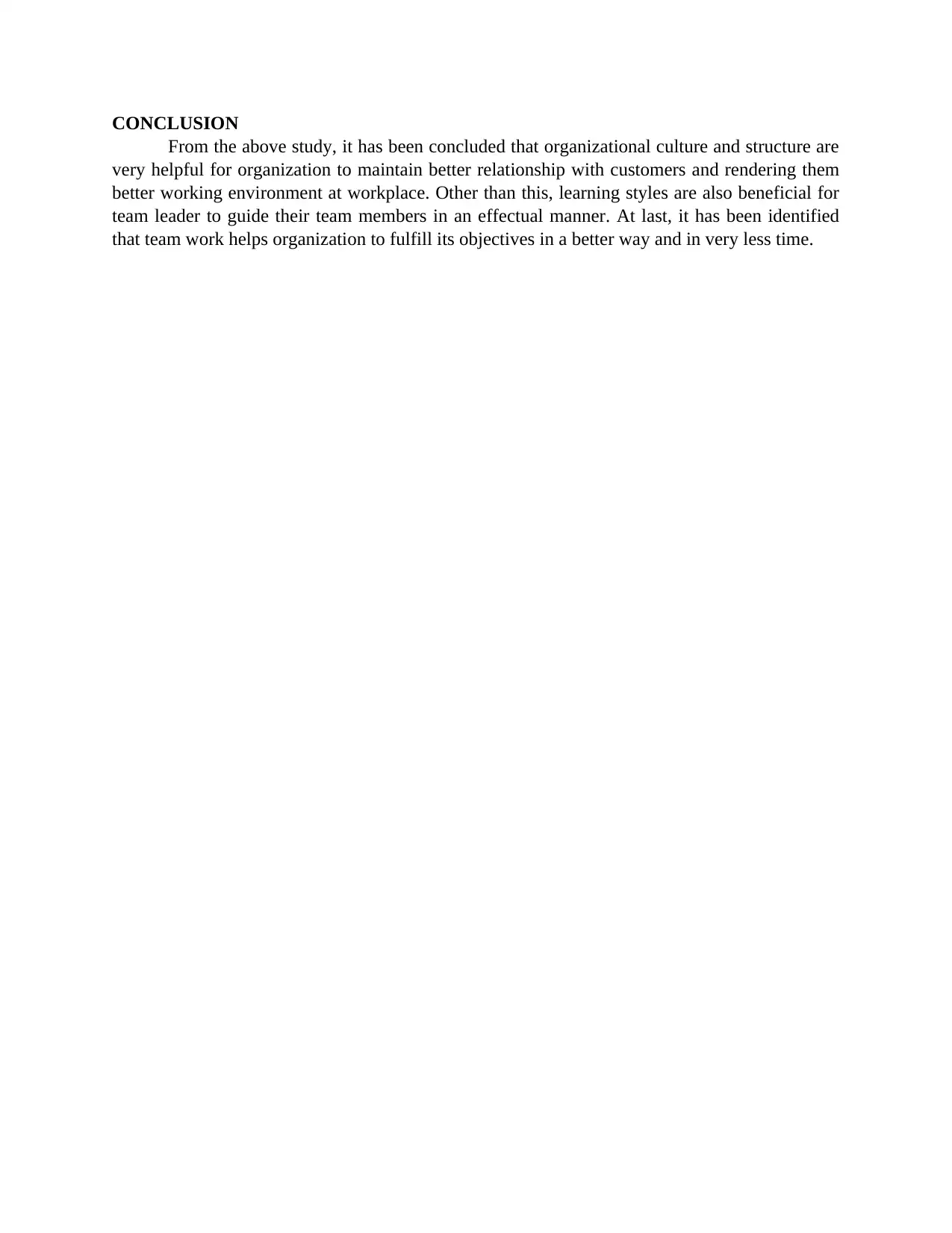
CONCLUSION
From the above study, it has been concluded that organizational culture and structure are
very helpful for organization to maintain better relationship with customers and rendering them
better working environment at workplace. Other than this, learning styles are also beneficial for
team leader to guide their team members in an effectual manner. At last, it has been identified
that team work helps organization to fulfill its objectives in a better way and in very less time.
From the above study, it has been concluded that organizational culture and structure are
very helpful for organization to maintain better relationship with customers and rendering them
better working environment at workplace. Other than this, learning styles are also beneficial for
team leader to guide their team members in an effectual manner. At last, it has been identified
that team work helps organization to fulfill its objectives in a better way and in very less time.
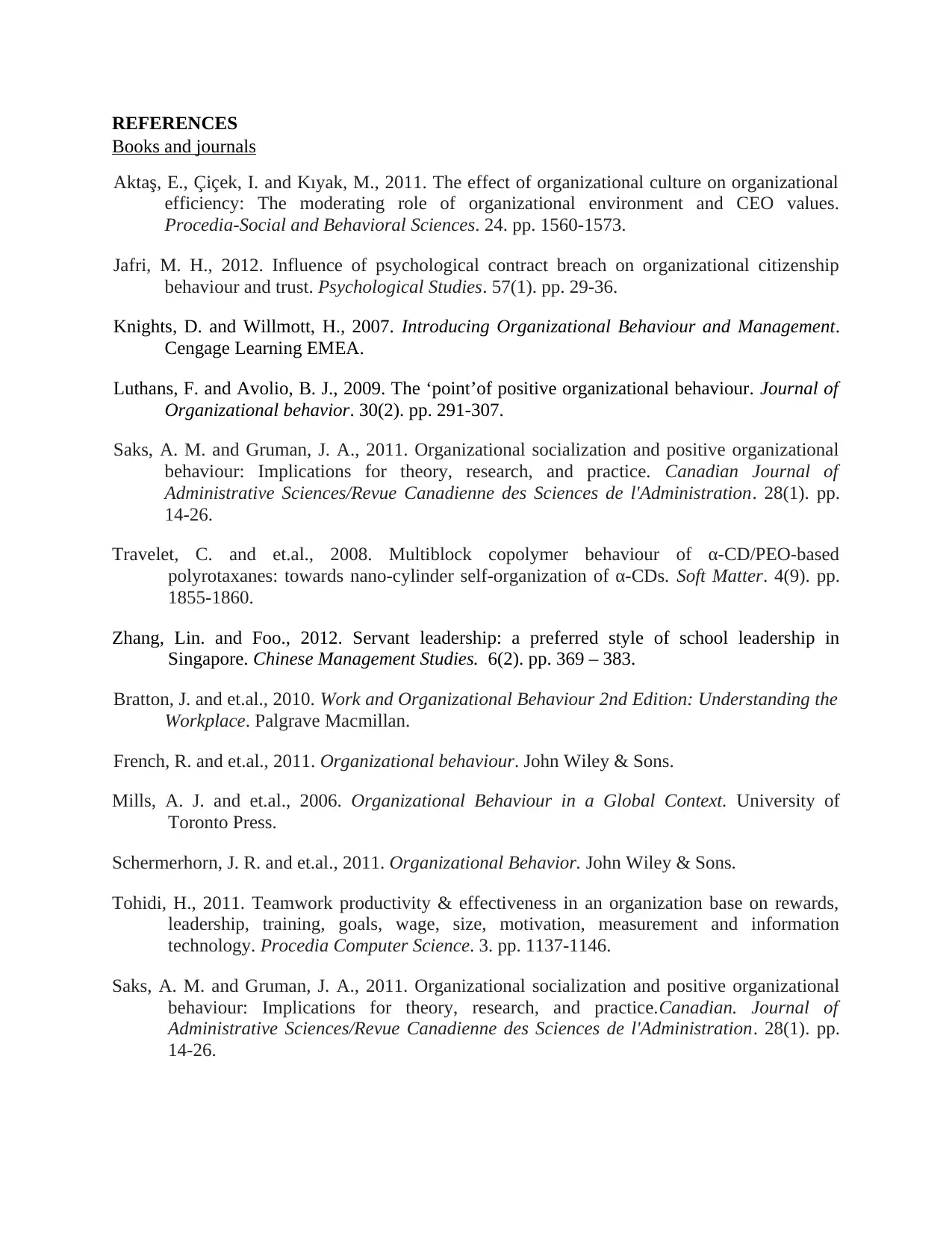
REFERENCES
Books and journals
Aktaş, E., Çiçek, I. and Kıyak, M., 2011. The effect of organizational culture on organizational
efficiency: The moderating role of organizational environment and CEO values.
Procedia-Social and Behavioral Sciences. 24. pp. 1560-1573.
Jafri, M. H., 2012. Influence of psychological contract breach on organizational citizenship
behaviour and trust. Psychological Studies. 57(1). pp. 29-36.
Knights, D. and Willmott, H., 2007. Introducing Organizational Behaviour and Management.
Cengage Learning EMEA.
Luthans, F. and Avolio, B. J., 2009. The ‘point’of positive organizational behaviour. Journal of
Organizational behavior. 30(2). pp. 291-307.
Saks, A. M. and Gruman, J. A., 2011. Organizational socialization and positive organizational
behaviour: Implications for theory, research, and practice. Canadian Journal of
Administrative Sciences/Revue Canadienne des Sciences de l'Administration. 28(1). pp.
14-26.
Travelet, C. and et.al., 2008. Multiblock copolymer behaviour of α-CD/PEO-based
polyrotaxanes: towards nano-cylinder self-organization of α-CDs. Soft Matter. 4(9). pp.
1855-1860.
Zhang, Lin. and Foo., 2012. Servant leadership: a preferred style of school leadership in
Singapore. Chinese Management Studies. 6(2). pp. 369 – 383.
Bratton, J. and et.al., 2010. Work and Organizational Behaviour 2nd Edition: Understanding the
Workplace. Palgrave Macmillan.
French, R. and et.al., 2011. Organizational behaviour. John Wiley & Sons.
Mills, A. J. and et.al., 2006. Organizational Behaviour in a Global Context. University of
Toronto Press.
Schermerhorn, J. R. and et.al., 2011. Organizational Behavior. John Wiley & Sons.
Tohidi, H., 2011. Teamwork productivity & effectiveness in an organization base on rewards,
leadership, training, goals, wage, size, motivation, measurement and information
technology. Procedia Computer Science. 3. pp. 1137-1146.
Saks, A. M. and Gruman, J. A., 2011. Organizational socialization and positive organizational
behaviour: Implications for theory, research, and practice.Canadian. Journal of
Administrative Sciences/Revue Canadienne des Sciences de l'Administration. 28(1). pp.
14-26.
Books and journals
Aktaş, E., Çiçek, I. and Kıyak, M., 2011. The effect of organizational culture on organizational
efficiency: The moderating role of organizational environment and CEO values.
Procedia-Social and Behavioral Sciences. 24. pp. 1560-1573.
Jafri, M. H., 2012. Influence of psychological contract breach on organizational citizenship
behaviour and trust. Psychological Studies. 57(1). pp. 29-36.
Knights, D. and Willmott, H., 2007. Introducing Organizational Behaviour and Management.
Cengage Learning EMEA.
Luthans, F. and Avolio, B. J., 2009. The ‘point’of positive organizational behaviour. Journal of
Organizational behavior. 30(2). pp. 291-307.
Saks, A. M. and Gruman, J. A., 2011. Organizational socialization and positive organizational
behaviour: Implications for theory, research, and practice. Canadian Journal of
Administrative Sciences/Revue Canadienne des Sciences de l'Administration. 28(1). pp.
14-26.
Travelet, C. and et.al., 2008. Multiblock copolymer behaviour of α-CD/PEO-based
polyrotaxanes: towards nano-cylinder self-organization of α-CDs. Soft Matter. 4(9). pp.
1855-1860.
Zhang, Lin. and Foo., 2012. Servant leadership: a preferred style of school leadership in
Singapore. Chinese Management Studies. 6(2). pp. 369 – 383.
Bratton, J. and et.al., 2010. Work and Organizational Behaviour 2nd Edition: Understanding the
Workplace. Palgrave Macmillan.
French, R. and et.al., 2011. Organizational behaviour. John Wiley & Sons.
Mills, A. J. and et.al., 2006. Organizational Behaviour in a Global Context. University of
Toronto Press.
Schermerhorn, J. R. and et.al., 2011. Organizational Behavior. John Wiley & Sons.
Tohidi, H., 2011. Teamwork productivity & effectiveness in an organization base on rewards,
leadership, training, goals, wage, size, motivation, measurement and information
technology. Procedia Computer Science. 3. pp. 1137-1146.
Saks, A. M. and Gruman, J. A., 2011. Organizational socialization and positive organizational
behaviour: Implications for theory, research, and practice.Canadian. Journal of
Administrative Sciences/Revue Canadienne des Sciences de l'Administration. 28(1). pp.
14-26.
⊘ This is a preview!⊘
Do you want full access?
Subscribe today to unlock all pages.

Trusted by 1+ million students worldwide
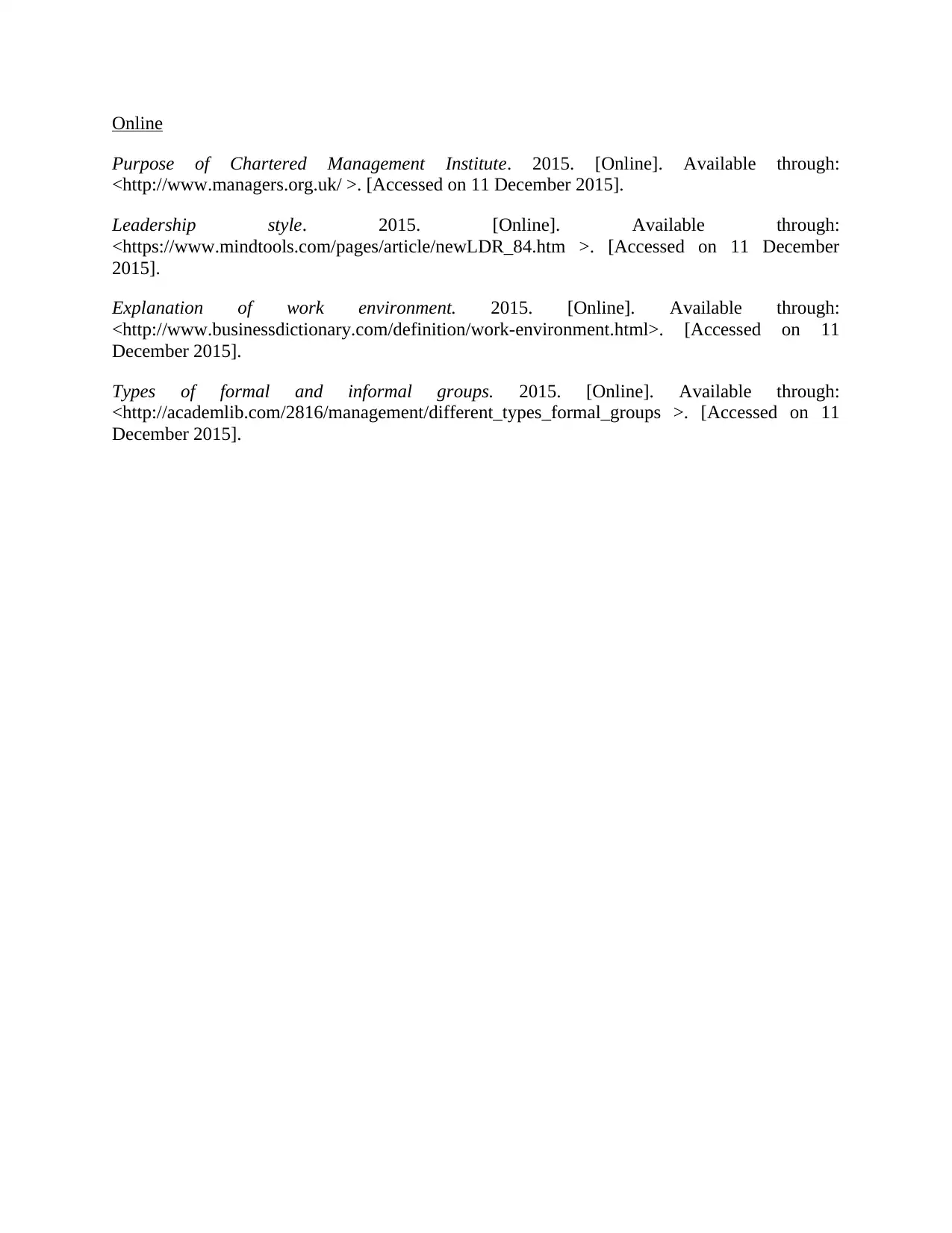
Online
Purpose of Chartered Management Institute. 2015. [Online]. Available through:
<http://www.managers.org.uk/ >. [Accessed on 11 December 2015].
Leadership style. 2015. [Online]. Available through:
<https://www.mindtools.com/pages/article/newLDR_84.htm >. [Accessed on 11 December
2015].
Explanation of work environment. 2015. [Online]. Available through:
<http://www.businessdictionary.com/definition/work-environment.html>. [Accessed on 11
December 2015].
Types of formal and informal groups. 2015. [Online]. Available through:
<http://academlib.com/2816/management/different_types_formal_groups >. [Accessed on 11
December 2015].
Purpose of Chartered Management Institute. 2015. [Online]. Available through:
<http://www.managers.org.uk/ >. [Accessed on 11 December 2015].
Leadership style. 2015. [Online]. Available through:
<https://www.mindtools.com/pages/article/newLDR_84.htm >. [Accessed on 11 December
2015].
Explanation of work environment. 2015. [Online]. Available through:
<http://www.businessdictionary.com/definition/work-environment.html>. [Accessed on 11
December 2015].
Types of formal and informal groups. 2015. [Online]. Available through:
<http://academlib.com/2816/management/different_types_formal_groups >. [Accessed on 11
December 2015].
Paraphrase This Document
Need a fresh take? Get an instant paraphrase of this document with our AI Paraphraser
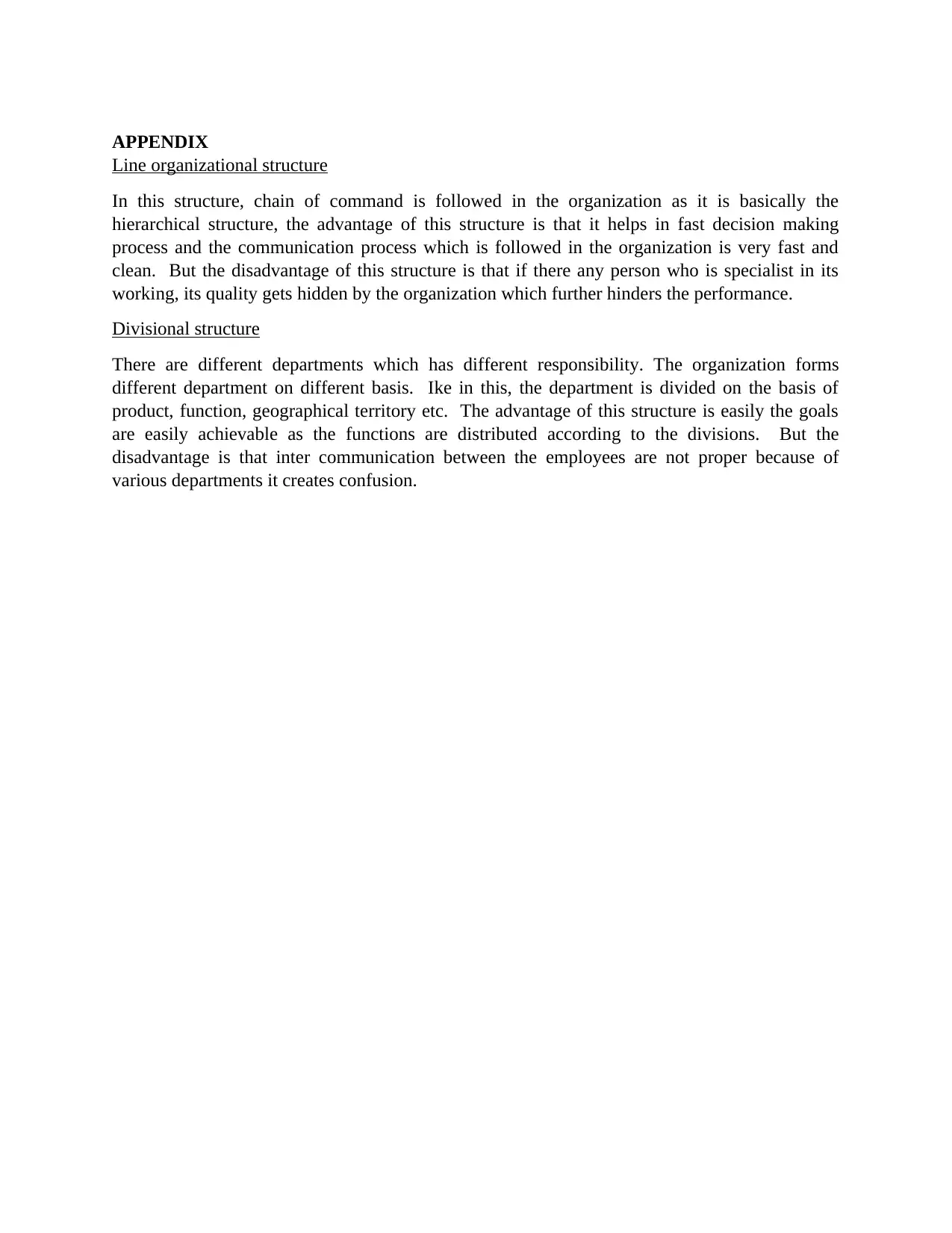
APPENDIX
Line organizational structure
In this structure, chain of command is followed in the organization as it is basically the
hierarchical structure, the advantage of this structure is that it helps in fast decision making
process and the communication process which is followed in the organization is very fast and
clean. But the disadvantage of this structure is that if there any person who is specialist in its
working, its quality gets hidden by the organization which further hinders the performance.
Divisional structure
There are different departments which has different responsibility. The organization forms
different department on different basis. Ike in this, the department is divided on the basis of
product, function, geographical territory etc. The advantage of this structure is easily the goals
are easily achievable as the functions are distributed according to the divisions. But the
disadvantage is that inter communication between the employees are not proper because of
various departments it creates confusion.
Line organizational structure
In this structure, chain of command is followed in the organization as it is basically the
hierarchical structure, the advantage of this structure is that it helps in fast decision making
process and the communication process which is followed in the organization is very fast and
clean. But the disadvantage of this structure is that if there any person who is specialist in its
working, its quality gets hidden by the organization which further hinders the performance.
Divisional structure
There are different departments which has different responsibility. The organization forms
different department on different basis. Ike in this, the department is divided on the basis of
product, function, geographical territory etc. The advantage of this structure is easily the goals
are easily achievable as the functions are distributed according to the divisions. But the
disadvantage is that inter communication between the employees are not proper because of
various departments it creates confusion.
1 out of 11
Related Documents
Your All-in-One AI-Powered Toolkit for Academic Success.
+13062052269
info@desklib.com
Available 24*7 on WhatsApp / Email
![[object Object]](/_next/static/media/star-bottom.7253800d.svg)
Unlock your academic potential
Copyright © 2020–2025 A2Z Services. All Rights Reserved. Developed and managed by ZUCOL.





